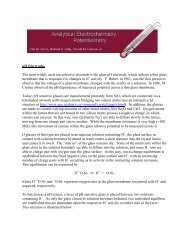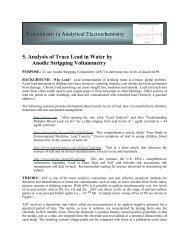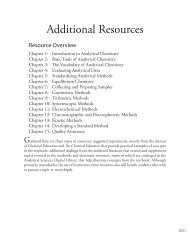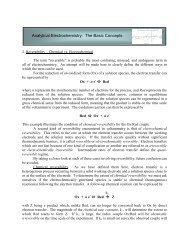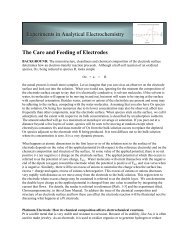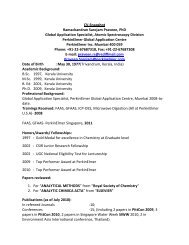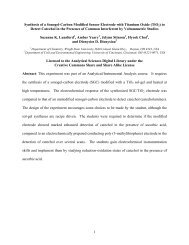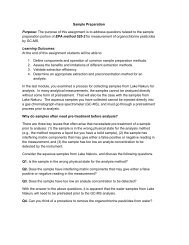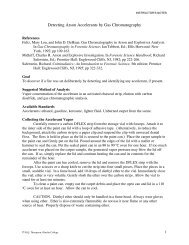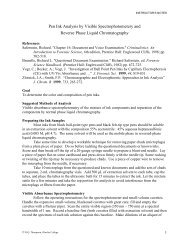1120 Analytical Chemistry 2.0<strong>Appendix</strong> 16: Countercurrent SeparationsIn 1949, Lyman Craig introduced an improved method for separating analytes with similar distribution ratios. 1The technique, which is known as a countercurrent liquid–liquid extraction, is outlined in Figure A16.1 anddiscussed in detail below. In contrast to a sequential liquid–liquid extraction, in which we repeatedly extractthe sample containing the analyte, a countercurrent extraction uses a serial extraction of both the sample andthe extracting phases. Although countercurrent separations are no longer common—chromatographic separationsare far more efficient in terms of resolution, time, and ease of use—the theory behind a countercurrentextraction remains useful as an introduction to the theory of chromatographic separations.To track the progress of a countercurrent liquid-liquid extraction we need to adopt a labeling convention.As shown in Figure A16.1, in each step of a countercurrent extraction we first complete the extraction andthen transfer the upper phase to a new tube containing a portion of the fresh lower phase. Steps are labeledsequentially beginning with zero. Extractions take place in a series of tubes that also are labeled sequentially,starting with zero. The upper and lower phases in each tube are identified by a letter and number, with theletters U and L representing, respectively, the upper phase and the lower phase, and the number indicating thestep in the countercurrent extraction in which the phase was first introduced. For example, U 0 is the upperphase introduced at step 0 (during the first extraction), and L 2 is the lower phase introduced at step 2 (duringthe third extraction). Finally, the partitioning of analyte in any extraction tube results in a fraction p remainingin the upper phase, and a fraction q remaining in the lower phase. Values of q are calculated using equationA16.1, which is identical to equation 7.26 in Chapter 7.( q )aq1( molesaq) V1aq= =( molesaq) DV + V0orgaqA16.1The fraction p, of course is equal to 1 – q. Typically V aq and V org are equal in a countercurrent extraction, althoughthis is not a requirement.Let’s assume that the analyte we wish to isolate is present in an aqueous phase of 1 M HCl, and that theorganic phase is benzene. Because benzene has the smaller density, it is the upper phase, and 1 M HCl is thelower phase. To begin the countercurrent extraction we place the aqueous sample containing the analyte in tube0 along with an equal volume of benzene. As shown in Figure A16.1a, before the extraction all the analyte ispresent in phase L 0 . When the extraction is complete, as shown in Figure A16.1b, a fraction p of the analyte ispresent in phase U 0 , and a fraction q is in phase L 0 . This completes step 0 of the countercurrent extraction. If westop here, there is no difference between a simple liquid–liquid extraction and a countercurrent extraction.After completing step 0, we remove phase U 0 and add a fresh portion of benzene, U 1 , to tube 0 (see FigureA16.1c). This, too, is identical to a simple liquid-liquid extraction. Here is where the power of the countercurrentextraction begins—instead of setting aside the phase U 0 , we place it in tube 1 along with a portion ofanalyte-free aqueous 1 M HCl as phase L 1 (see Figure A16.1c). Tube 0 now contains a fraction q of the analyte,and tube 1 contains a fraction p of the analyte. Completing the extraction in tube 0 results in a fraction p ofits contents remaining in the upper phase, and a fraction q remaining in the lower phase. Thus, phases U 1and L 0 now contain, respectively, fractions pq and q 2 of the original amount of analyte. Following the samelogic, it is easy to show that the phases U 0 and L 1 in tube 1 contain, respectively, fractions p 2 and pq of analyte.This completes step 1 of the extraction (see Figure A16.1d). As shown in the remainder of Figure A16.1, thecountercurrent extraction continues with this cycle of phase transfers and extractions.1 Craig, L. C. J. Biol. Chem. 1944, 155, 519–534.
Appendices1121(a)U 00L 01extract(b)U 0pL 0qtransfernewphase(c)U 10U 0pL 0qnewphaseL 10extractextract(d)U 1pqU 0p2L 0q2transferL 1pqtransfernewphase(e)U 20U 1pqU 0p2L 0q2L 1pqnewphaseL 20newphaseextract(f)(g)U 2pq2L 0q3U 30L 0q3transferextractU 12p2qL 12pq2U 2pq2L 12pq2transferextractU 0p3L 2p2qU 12p2qL 2p2qtransfernewphaseU 0p3Tube 0 Tube 1 Tube 2 Tube 3L 30Figure A16.1 Scheme for a countercurrentextraction: (a) The sample containing theanalyte begins in L 0 and is extracted with afresh portion of the upper, or mobile phase;(b) The extraction takes place, transferring afraction p of analyte to the upper phase andleaving a fraction q of analyte in the lower,or stationary phase; (c) When the extractionis complete, the upper phase is transferred tothe next tube, which contains a fresh portionof the sample’s solvent, and a fresh portionof the upper phase is added to tube 0. In (d)through (g), the process continues, with theaddition of two more tubes.



